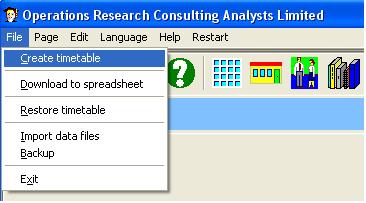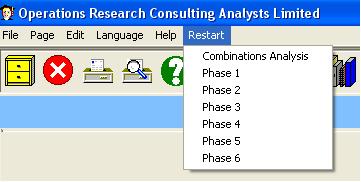
Having entered your school data you can create your timetable. Select Create Timetable
from File. The program goes through six phases. Phase 1 checks for errors in the data.
For example, all normal classes must have a residual of zero periods. It also gives you the
opportunity to do an analysis of the combination classes.
Phase 2 attempts to construct a feasible timetable, that is, one which provides all of
the subjects specified with no teacher teaching more than one class at a time. All
overrides must also be honoured.
Once phase 3 starts you know you have a timetable. Phases 3 to 5 move the classes around
to create necessary double and triple periods.
Phase 6 does the room allocation.

You can stop one of the phases and restart from the same or earlier phase by using the
Restart facility. Restarting, for example from phase 3, can improve the quality of the
final timetable. Restarting from phase 6 will cause the program to re-do the room
allocation.
You have the option of restarting with an analysis of the combinations if you suspect
that these are causing difficulty.
If you cannot get past phase 2 try the following to determine where the problem is.
Remove all overrides. Remove rooms from the Combination and Normal Class screens.
Examine the teacher workloads to see if any teacher has an unusually high workload.
Perhaps there are too many combinations. As a last resort you can send us your data
files and we will analyse the data for you.
Generally, the simpler the timetable the better will be the quality of the final
timetable. A good quality timetable will have all of the double and triple periods
scheduled and subjects will be spread over the school week.